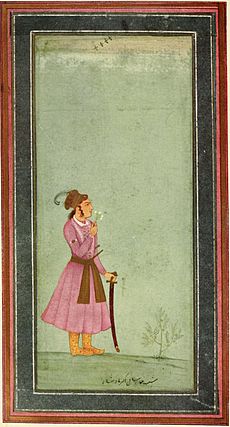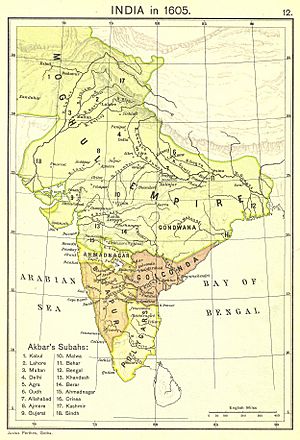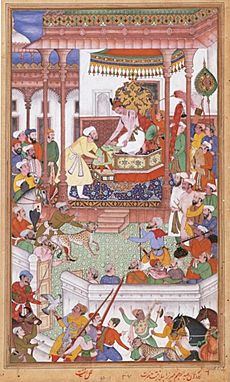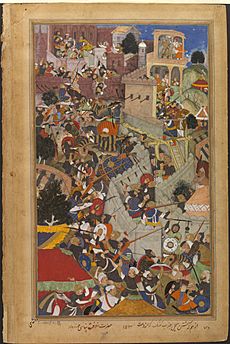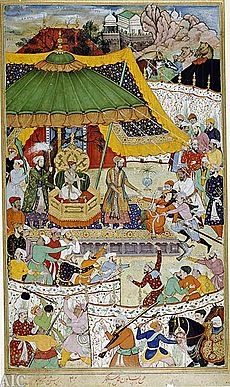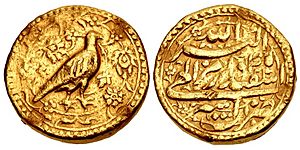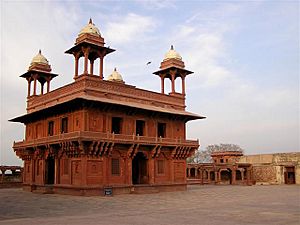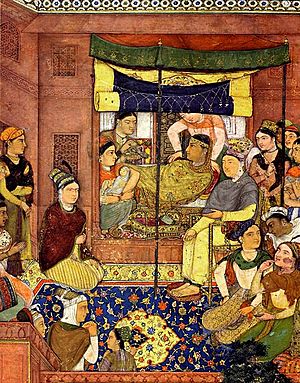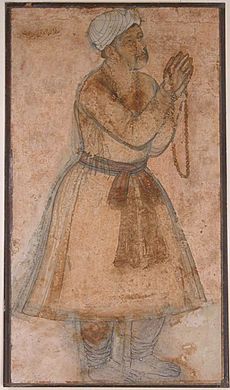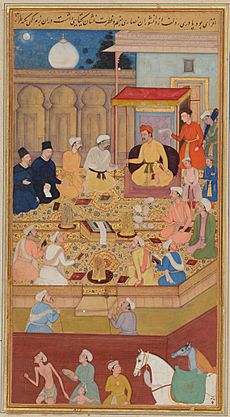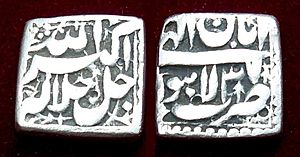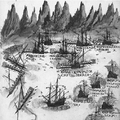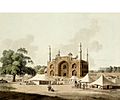Akbar facts for kids
Quick facts for kids Jalal-ud-din MuhammadAkbar |
|||||||||
|---|---|---|---|---|---|---|---|---|---|
| Padishah Ghazi |
|||||||||
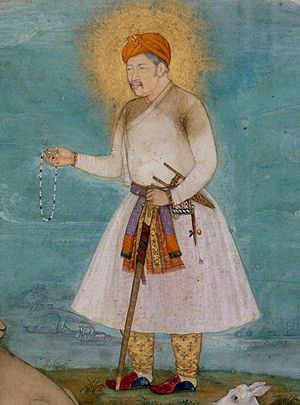
Akbar by Govardhan, c. 1630
|
|||||||||
| 3rd Emperor of the Mughal Empire | |||||||||
| Reign | 11 February 1556 – 27 October 1605 | ||||||||
| Coronation | 14 February 1556 | ||||||||
| Predecessor | Humayun | ||||||||
| Successor | Jahangir | ||||||||
| Regent | Bairam Khan (1556–1560) | ||||||||
| Born | Jalal-ud-din Muhammad Akbar 15 October 1542 Amarkot, Rajputana (present-day Umerkot, Sindh, Pakistan) |
||||||||
| Died | 27 October 1605 (aged 63) Fatehpur Sikri, Agra, Mughal Empire (present-day Uttar Pradesh, India) |
||||||||
| Burial | November 1605 Akbar's Tomb, Sikandra, Agra |
||||||||
| Consorts |
|
||||||||
| Wives |
|
||||||||
| Issue Detail |
|
||||||||
|
|||||||||
| House | House of Babur | ||||||||
| Dynasty | Timurid dynasty | ||||||||
| Father | Humayun | ||||||||
| Mother | Hamida Banu Begum | ||||||||
| Religion | Sunni Islam Din-e-Illahi |
||||||||
Akbar the Great (born October 15, 1542 – died October 27, 1605) was the third Mughal emperor. He ruled a large empire in India from 1556 to 1605. Akbar took over after his father, Humayun, passed away. He was very young, so a trusted general named Bairam Khan helped him rule and expand the Mughal lands.
Akbar was a strong leader and a successful general. He greatly expanded the Mughal Empire to cover most of the Indian subcontinent. His power spread far and wide because the Mughals were strong in military, politics, culture, and economy. To unite his huge empire, Akbar created a central system of government. He also made peace with rulers he conquered, often through marriage and diplomacy.
Akbar wanted peace in his empire, which had many different religions and cultures. He made policies that earned him the support of his non-Muslim people. He focused on loyalty to himself as emperor, rather than just tribal ties or Islamic identity. This helped create a unique Indo-Persian culture in his empire.
Under Akbar, Mughal India had a strong economy. This led to more trade and support for arts and culture. Akbar loved art and learning. He had a huge library with over 24,000 books in many languages like Sanskrit, Urdu, Persian, and Arabic. He even helped organize the books himself! He also set up schools for both Muslims and Hindus. His courts in Delhi, Agra, and Fatehpur Sikri became centers for art, writing, and learning. Mughal art, painting, and architecture blended with Indian styles. Akbar also created a new belief system called Din-i-Ilahi, which combined ideas from different religions like Islam and Hinduism.
Akbar's rule changed Indian history a lot. The Mughal Empire grew much bigger and richer. He built a powerful army and made good changes to society and government. He was the first Mughal ruler to gain the trust of non-Muslims by removing a special tax on them and giving them important jobs. He encouraged the translation of Sanskrit books and took part in local festivals. He knew that a stable empire needed everyone's cooperation. Because of him, the Mughal Empire became a place where many cultures could live together. His son, Prince Salim, who later became Jahangir, took over after him.
Contents
Early Life and Becoming Emperor
Akbar was born on October 15, 1542, in a fort in Umerkot, Rajputana. His parents, Humayun and Hamida Banu Begum, were seeking safety there after Humayun lost battles to Sher Shah Suri.
During his father's time in exile, Akbar grew up in Kabul. He learned to hunt, run, and fight, becoming a brave warrior. Interestingly, he never learned to read or write. But this didn't stop him from seeking knowledge. People would read to him every evening. When he was about nine, he married his cousin, Ruqaiya Sultan Begum.
In 1555, Humayun won back Delhi. But he died a few months later. Akbar's guardian, Bairam Khan, kept Humayun's death a secret for a while to prepare for Akbar to become emperor. On February 14, 1556, at just 14 years old, Akbar was crowned emperor in Kalanaur, Punjab. He was called Shahanshah ("King of Kings"). Bairam Khan continued to rule for him until Akbar was old enough to take full control.
Akbar's Military Successes
Building a Strong Army
Akbar had many successful military campaigns that made Mughal rule strong across India. He made his army very powerful by organizing it well. He used a system called Mansabdari, which helped keep the Mughal army strong for a long time.
He also improved weapons and defenses. Akbar was interested in matchlock guns and used them effectively. He got help from the Ottomans and Europeans, especially the Portuguese, to get better firearms and cannons. Mughal weapons became much better than those of other rulers in India. This mastery of warfare helped the Mughals succeed.
Battles for North India
When Humayun died, Mughal rule was not very stable. An enemy general named Hemu took over Delhi and Agra. Akbar's guardian, Bairam Khan, convinced him to fight back. On November 5, 1556, Akbar's army defeated Hemu at the Second Battle of Panipat. This was a huge victory.
After this, Mughal forces took Delhi and Agra. Akbar then went to Punjab to deal with another enemy, Sikandar Shah Suri, who fled. The Mughals also took Lahore and Multan. By 1558, Akbar controlled Ajmer, which was important for entering Rajputana. They also captured Gwalior Fort, a strong fort north of the Narmada River.
Akbar made it clear that the Mughals were in India to stay. This was different from his grandfather, Babur, and father, Humayun, who were seen more as temporary rulers.
Expanding into Central India
By 1559, the Mughals started moving south into Rajputana and Malwa. But Akbar had disagreements with Bairam Khan. At 18, Akbar wanted to rule more directly. In 1560, he dismissed Bairam Khan, who then rebelled but was defeated and forgiven. Sadly, Bairam Khan was later killed on his way to Mecca.
Akbar continued his military actions. His army conquered Malwa, defeating its ruler, Baz Bahadur. Malwa became a Mughal province. Akbar also dealt with rebellious relatives and nobles. When a powerful group of Uzbek chiefs rebelled in 1564, Akbar defeated them. He pardoned them at first, but when they rebelled again, he put down their uprising firmly.
In 1564, Mughal forces began to conquer Garha, a hilly area in central India. It was ruled by a young king and his mother, Rani Durgavati, a brave Rajput queen. Durgavati died fighting, and the Mughals took huge amounts of treasure and elephants. Akbar later resolved disputes with his generals over the spoils.
Assassination Attempt
Around 1564, someone tried to assassinate Akbar. This happened when he was returning from a visit to a holy place near Delhi. The attacker was caught and executed.
Conquering Rajputana
After making northern India secure, Akbar focused on Rajputana. He knew that to be truly safe, his empire needed control over this region. Many Rajput states accepted Akbar's rule. However, the rulers of Mewar and Marwar, Udai Singh II and Chandrasen Rathore, resisted. Udai Singh was from a very respected Rajput family.
In 1567, Akbar attacked the Chittor Fort in Mewar. This fort was very important because it was on the shortest route from Agra to Gujarat. Chittorgarh fell in February 1568 after a four-month siege. Akbar saw this as a great victory. He ordered statues of the brave Rajput defenders, Jaimal and Patta, to be placed at the gates of his fort in Agra.
The fall of Chittorgarh was followed by an attack on the Ranthambore Fort in 1568, which was also captured. Akbar now controlled almost all of Rajputana. Most Rajput kings had submitted to him. Only the Mewar clan continued to resist. To celebrate his victories, Akbar started building a new capital city called Fatehpur Sikri ("the city of victory") in 1569.
Taking Control of Western and Eastern India
Akbar then aimed to conquer Gujarat and Bengal. These regions were important for trade with Asia, Africa, and Europe. Gujarat was also a hiding place for rebellious Mughal nobles. In 1572, Akbar moved into Gujarat, taking its capital, Ahmedabad. By 1573, he had driven out the rebels. Surat, a major trading city, also surrendered.
Akbar returned to Fatehpur Sikri and built the Buland Darwaza to celebrate his victories. But a rebellion forced him to return to Gujarat quickly. He traveled very fast and won a decisive victory on September 2, 1573. The conquest of Gujarat brought a lot of wealth to the Mughal Empire.
Next, Akbar focused on Bengal, where Afghan rulers still had power. In 1574, the Mughals captured Patna. Akbar left his generals to finish the campaign. The Mughal army won the Battle of Tukaroi in 1575, leading to Bengal becoming part of the Mughal Empire.
Campaigns in Afghanistan and Central Asia
After his conquests, Akbar focused on domestic matters until 1581. His brother, Mirza Muhammad Hakim, invaded Punjab again. Akbar drove him back to Kabul and took control of the city. He left his sister in charge and later pardoned his brother. When Muhammad Hakim died in 1585, Kabul officially became a Mughal province.
Akbar then spent 13 years in the north, moving his capital to Lahore. He dealt with threats from the Uzbeks, who had driven his grandfather, Babur, out of Central Asia. He also faced restless Afghan tribes. In 1586, Akbar made a deal with the Uzbek leader, Abdullah Khan, to stay neutral in their conflicts. This allowed Akbar to focus on the Afghan tribes.
A military expedition against the Afghan tribes in 1586 was a disaster, and a famous minister, Birbal, was killed. Akbar immediately sent new armies and brought the Yusufzai tribe under control. He built many forts to secure the region. By 1600, most rebellious Afghan tribes were subdued, and Mughal rule in Afghanistan was secure.
Conquests in the Indus Valley
While in Lahore, Akbar also worked to control the Indus valley. In 1585, he sent an army to conquer Kashmir because its king refused to send his son as a hostage. Kashmir was taken, and nearby Tibetan areas like Baltistan and Ladakh also pledged loyalty to Akbar.
The Mughals also moved to conquer Sindh in the lower Indus valley. After some battles, the ruler of Sindh, Mirza Jani Beg, surrendered to Akbar in 1591. By 1593, Sindh was fully part of the Mughal Empire.
Taking Parts of Baluchistan
By 1586, some Baluchi chiefs had already accepted Akbar's rule. In 1595, Akbar ordered his forces to conquer the rest of Baluchistan from Afghan control. The Mughal general, Mir Masum, defeated local chiefs. As a result, parts of modern-day Pakistan and Afghanistan, including the Makran coast, became part of the Mughal Empire.
Safavids and Kandahar
Kandahar was an important city on the border between the Mughal and Safavid empires. The Safavids had taken it from the Mughals in 1558. Akbar wanted to get it back, especially after securing other northern areas. The Safavid emperor was busy fighting the Ottomans, so he couldn't send help to Kandahar.
In 1593, an exiled Safavid prince came to Akbar's court and pledged loyalty. Seeing this, the Safavid governor of Kandahar also decided to join the Mughals. Kandahar was finally secured in 1595. This strengthened the Mughals' position, but Akbar and the Persian Shah still exchanged gifts and ambassadors.
Deccan Sultans
In 1593, Akbar began military actions against the Deccan Sultans in southern India who had not accepted his rule. He besieged Ahmednagar Fort in 1595. He took Asirgarh Fort in 1601. By the time of his death in 1605, Akbar controlled a vast territory from the Bay of Bengal to Kandahar.
Akbar's Government and Economy
How Akbar Governed
Akbar improved the central government system. He made clear rules for how different departments should work.
- The wazir was in charge of all money and land management.
- The mir bakshi was the head of the army. He also gathered information and suggested military appointments.
- The mir saman managed the royal household, including the palaces and bodyguards.
- The qazi was the head of the justice system and religious matters.
Taxation System
Akbar reformed the land tax system. He used a system where land was measured and taxed based on its crops. This was fair but sometimes hard on farmers. So, he changed to a system called dahsala in 1580. Under this, the tax was one-third of the average produce over the past ten years, paid in cash. This system was improved to consider local prices.
Farmers received tax breaks if harvests failed due to floods or droughts. Akbar also encouraged better farming methods. Local officials were given incentives to collect taxes fully.
Military Organization
Akbar organized his army and nobles using the mansabdari system. Each officer, called a mansabdar, was given a rank. They had to provide a certain number of cavalry soldiers to the imperial army. The highest ranks were usually for princes.
The empire's permanent army was small. Most forces came from the mansabdars. Officers were promoted based on their skill and the emperor's favor. They had to maintain a certain number of cavalrymen and horses. Akbar made sure the army was high quality. Horses were inspected regularly, and Arabian horses were preferred. Mansabdars were paid very well.
Capital Cities
Akbar was a follower of a holy man named Salim Chishti who lived near Agra. Believing the area was lucky, Akbar built a mosque there. After his victories, he started building a new capital city, Fatehpur Sikri, in 1569. It was named "city of victory" after his conquest of Gujarat. He built palaces and a large artificial lake there.
However, the city was later abandoned. Some believe it was due to a lack of water. Others think Akbar needed to be closer to the northwest parts of his empire, so he moved the capital to Lahore in 1585. In 1599, he moved his capital back to Agra, where he ruled until his death.
Economy and Trade
Trade and Commerce
Akbar's rule saw a lot of growth in trade. The Mughal government supported traders. They offered protection and charged low customs duties to encourage foreign trade. They also made sure that local officials repaid traders for stolen goods. To keep roads safe, highway police were used.
Akbar also improved roads, especially through the Khyber Pass, a popular route for traders from Kabul to India. He built forts in cities like Multan and Lahore and smaller forts along the border. This helped secure trade routes with Persia and Central Asia. His chief wife, Mariam-uz-Zamani, even ran a large trade business, sending indigo, spices, and cotton to Gulf nations.
Coins and Currency
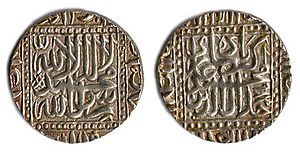
Akbar made many changes to coins. His coins were new and exciting in India's history of money. Unlike his father's and grandfather's basic coins, Akbar's long reign allowed him to experiment.
He introduced coins with beautiful designs like flowers and unique shapes. Some coins even had his portrait, though these were likely made by his son, Prince Salim. Akbar's tolerant views were shown in coins like the "Ram-Sita" silver coin. Later, coins reflected his new belief system, Din-e-Ilahi. These innovations set a new standard for Mughal coins.
Akbar's Diplomacy and Relations
Marriage Alliances
Long before Akbar, Hindu princesses sometimes married Muslim kings. But these marriages often didn't create lasting peace. Akbar's approach was different. When Hindu Rajput families married their daughters to him, they were treated with respect. Their fathers and brothers were given high positions in his court.
For example, Raja Bharmal of Amer gave his daughter, Mariam-uz-Zamani, in marriage to Akbar. She became the mother of Akbar's successor, Jahangir. Bharmal and his family gained high ranks in the court. Other Rajput kingdoms also formed alliances with Akbar, even if they didn't involve marriage.
These alliances had a big impact. While some Rajput women in Akbar's family converted to Islam, they usually had religious freedom. Their Hindu relatives became important nobles in the court. This led to a mix of Hindu and Muslim cultures. Later Mughal rulers even had both Mughal and Rajput blood, strengthening ties. Rajputs became strong allies, fighting for the Mughal army. Akbar's policy of religious tolerance meant that anyone could get a job in the government based on their skills, regardless of their religion.
Relations with the Portuguese

When Akbar became emperor, the Portuguese had strongholds on India's western coast. They controlled sea trade, which bothered Indian rulers. When Akbar took Gujarat in 1572, he gained access to the sea. He knew the Portuguese were a threat. He agreed to get a permit from them for his ships to sail in the Persian Gulf.
At first, the Portuguese chose diplomacy over war with the powerful Mughal army. Akbar tried to buy cannons from them, but they refused. He was concerned when he had to ask for a permit for ships carrying pilgrims to Mecca. In 1573, he ordered his officials not to provoke the Portuguese.
In 1579, Akbar invited Jesuits (Christian priests) from Goa to his court. He had the New Testament translated and allowed them to preach. One of his sons, Sultan Murad Mirza, was even taught by a Jesuit. However, the Jesuits sometimes criticized Islam, which angered Muslim scholars. This led to a rebellion by some Muslim clerics in 1581. Akbar put down the rebellion but became more careful.
Relations with the Ottoman Empire

Ottoman admirals visited the Mughal Empire to discuss the growing threat from the Portuguese. Akbar sent money and gifts to Mecca and Medina for needy pilgrims. In 1576, he sent a large group of pilgrims, including family members, on Hajj. He also funded a Sufi lodge in the Hijaz.
This increased Mughal presence in Mecca and Medina. Trade between the Mughals and Ottomans also grew. However, the pilgrims stayed too long and were eventually forced to return in 1582. This might be why Akbar stopped sending Hajj caravans after 1581.
Relations with the Safavid Dynasty

The Safavids of Persia and the Mughals had a long history. The Safavid ruler Tahmasp I had given refuge to Humayun. However, the Safavids were Shia Muslims, different from the Sunni Mughals. A main point of disagreement was control over Kandahar, a city on the border.
Kandahar was important for its location. The Safavids took it in 1558. Akbar tried to keep peaceful relations. After Tahmasp I died in 1576, there was civil war in Persia, and relations stopped for a decade. They restarted in 1587. Akbar's army took Kandahar peacefully in 1595. This made the Mughals stronger, but both empires continued to exchange ambassadors.
Akbar's Religious Policy
Akbar was a Sunni Muslim, but he grew up in a time when religious tolerance was encouraged. Many rulers before him had also tried to create harmony between Hindus and Muslims. His childhood teachers, who were Shia, also helped him develop a tolerant view.
Akbar held religious debates with different Muslim groups, Parsis, Hindus, Sikhs, Jains, Jews, and Jesuits. He was especially interested in Sufism. He even said that "the wisdom of Vedanta is the wisdom of Sufism."
Din-i Ilahi: A New Path
Akbar was deeply interested in religion and philosophy. In 1575, he built a hall called the Ibadat Khana ("House of Worship") in Fatehpur Sikri. He invited scholars and mystics to discuss spiritual matters. At first, only Muslims were allowed, but the discussions became heated. So, Akbar opened the Ibadat Khana to people of all religions, and even atheists. This shocked some traditional Muslim scholars.
Akbar realized that despite their differences, all religions had good practices. He tried to combine these into a new religious movement called Din-i-Ilahi. Some scholars say it wasn't a new religion but a way of thinking. Virtues in Din-i-Ilahi included generosity, forgiveness, kindness, and wisdom. Animal slaughter was forbidden.
The debates at Ibadat Khana didn't lead to better understanding among religions. So, Akbar stopped them in 1582. However, his interactions with different religious leaders convinced him that all religions had good things to offer. This led to his policy of sulh-e-kul (universal peace), which was key to his religious tolerance. Even at his death, his Muslim subjects remained loyal.
Relations with Hindus
Akbar allowed Hindus who had been forced to convert to Islam to return to Hinduism without punishment. He was so well-liked by Hindus that they sang songs praising him.
Akbar adopted some Hindu customs. He celebrated Diwali and allowed Hindu priests to tie special strings on his wrists for blessings. He stopped eating beef and forbade the sale of all meats on certain days. His son Jahangir and grandson Shah Jahan continued many of these practices. Akbar even drank water from the Ganges river, calling it "the water of immortality."
Relations with Jains

Akbar often discussed with Jain scholars and was influenced by their teachings. He was impressed by a Jain woman who had fasted for six months. He invited her teacher, Acharya Hiravijaya Suri, to Fatehpur Sikri.
Akbar was impressed by the Acharya's wisdom. The Jain arguments against eating meat convinced him to become a vegetarian. Akbar also issued orders that helped Jains, like banning animal slaughter. He removed a tax from Jain pilgrimage sites. The Indian Supreme Court has called Akbar "the architect of modern India" for his respect for Jainism.
Akbar's Personality and Legacy
Akbar's Character
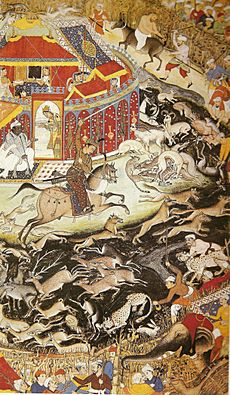
Akbar's life was recorded by his court historian Abul Fazl in the Akbarnama. Other writers also described his reign.
Akbar was a warrior, emperor, and general. He was also an animal trainer, keeping thousands of hunting cheetahs. He is believed to have been dyslexic, so he had people read to him daily. He had an amazing memory.
He was known as a wise emperor and a good judge of people. His son, Jahangir, praised his character. Akbar was not tall but was strongly built and agile. He was very brave, once killing a tigress with his sword alone. He was known for his leadership in battle and was always ready to take risks. He was usually kind to his relatives, even pardoning his rebellious brother. But he could be harsh with those who greatly angered him.
Akbar ate very little. He drank water from the Ganges river, which he called "the water of immortality." He loved fruits and ate less meat in his later years. He also visited Vrindavan, a holy place for Hindus, and allowed four temples to be built there.
Historical Accounts and Legacy
Akbar's reign led to many stories and legends about him. People from different religions wrote about him, showing how he was seen in different ways. This shows how his rule created a flexible state with a mix of cultures.
The Akbarnama is an official biography of Akbar written in Persian by Abul Fazl. It describes his life in detail and included many paintings. These paintings were an important part of Mughal art.
Family and Children
Akbar had several children. His sons included:
- Hassan Mirza (born and died in 1564)
- Hussain Mirza (born and died in 1564)
- Shahzada Salim (born 1569; died 1627) – He became the next emperor.
- Murad Mirza (born 1570; died 1599)
- Daniyal Mirza (born 1572; died 1605)
His daughters included:
- Fatima Banu Begum (born and died around 1562)
- Shahzada Khanam (born 1569)
- Mahi Begum (died 1577)
- Shakr-un-Nissa Begum (died 1653)
- Firoze Khannum (born 1575)
- Aram Banu Begum (born 1584; died 1624)
Akbar also adopted some children.
Death
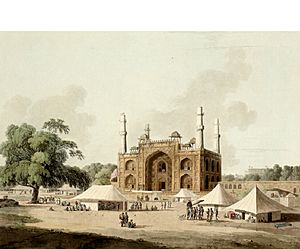
Akbar became ill with dysentery on October 3, 1605. He died on October 27, 1605. He was buried at his mausoleum in Sikandra, Agra, near the tomb of his wife, Mariam-uz-Zamani.
Akbar's Lasting Impact
Akbar left a rich legacy for the Mughal Empire and India. He made the Mughal Empire very strong after it had faced threats. He changed the government to be more open and tolerant, focusing on cultural unity. He also made important social reforms. These included stopping sati (a practice where a widow would burn herself), allowing widows to remarry, and raising the age for marriage.
Stories about Akbar and his wise minister, Birbal, are still popular in India. He and his Hindu wife, Mariam-uz-Zamani, are often seen as inspiring his policies of tolerance.
Some historical texts describe Akbar as a special ruler who brought different groups together. Time magazine even included him in its list of top 25 world leaders for his role in uniting India and promoting tolerance. However, in Pakistan, some historians view his policies negatively, believing they weakened the separate identity of Muslims.
Images for kids
See Also
 In Spanish: Akbar para niños
In Spanish: Akbar para niños


